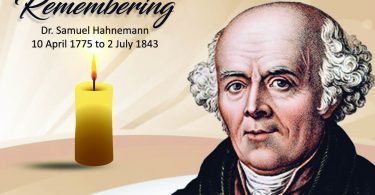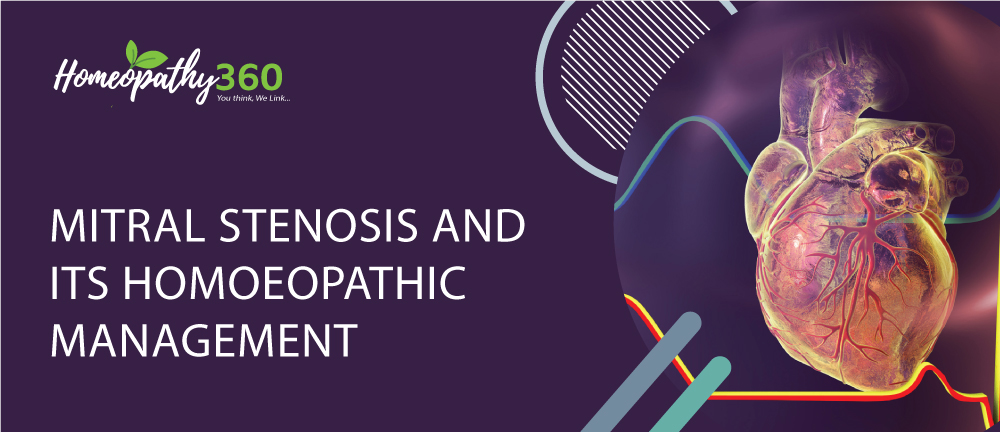
Mitral Stenosis & Its Homoeopathic Management
ABSTRACT
Mitral stenosis (MS) is a form of valvular heart disease. Mitral stenosis is characterized by narrowing of the mitral valve orifice. Today, the most common cause of mitral stenosis is rheumatic fever, but the stenosis usually appears clinically relevant only after several decades so mostly remain undiagnosed and common cause of dyspnoea and palpitation in female.
KEYWORDS– Mitral stenosis, Homoeopathy
INTRODUCTION–
Mitral stenosis (MS) is characterized by obstruction to left ventricular inflow at the level of mitral valve due to structural abnormality of the mitral valve apparatus. The most common cause of mitral stenosis is rheumatic fever. The association of atrial septal defect with rheumatic mitral stenosis is called Lutembacher syndrome.
Stenosis of the mitral valve typically occurs decades after the episode of acute rheumatic carditis. Acute insult leads to formation of multiple inflammatory foci (Aschoff bodies, perivascular mononuclear infiltrate) in the endocardium and myocardium
AETIOLOGY
The most common cause of mitral stenosis is RHEUMATIC FEVER. Uncommon causes of mitral stenosis are calcification of the mitral valve leaflets and congenital heart disease. Other causes are-
Congenital valvular heart disease-
1-Hunter’s syndrome.
2-Hurler’s syndrome.
3-Mitral annular calcification.
4-Rheumatoid arthritis.
5-Systemic lupus erythematosus.
6-Infective endocarditis with large vegetation.
7-Lutembacher’s syndrome.
8-Drugs- Methysergide.
PATHOPHYSIOLOGY OF MITRAL STENOSIS
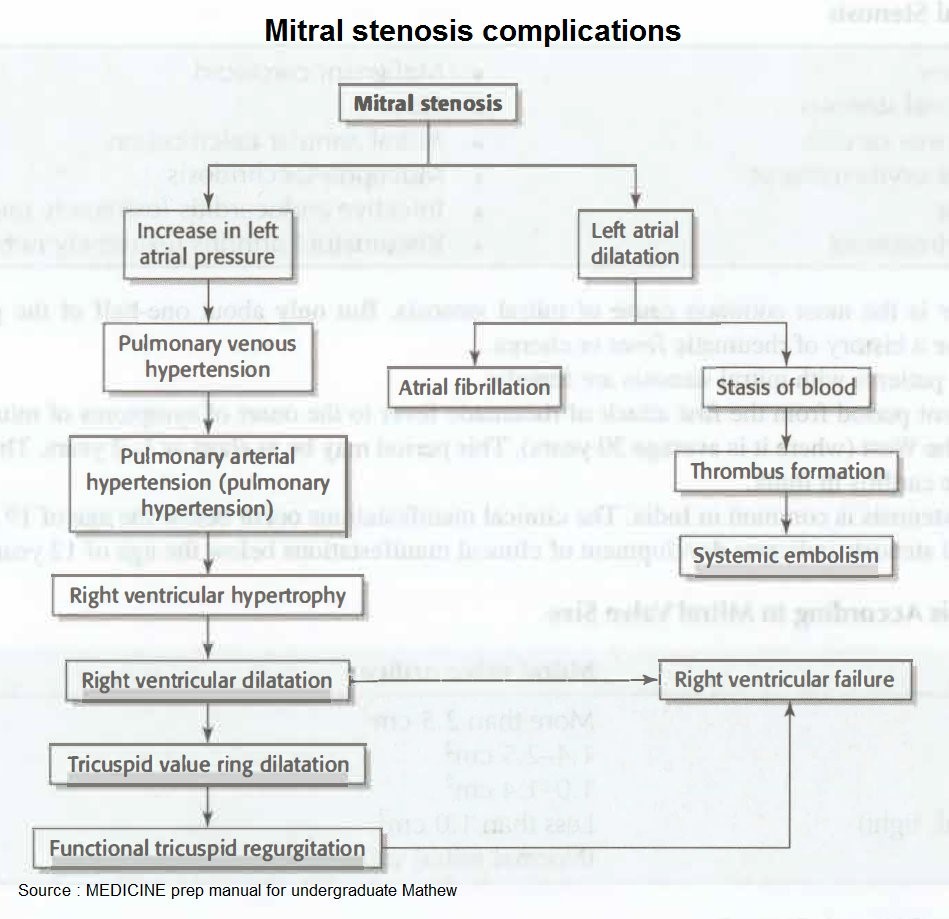
EPIDEMIOLOGY
Rheumatic mitral stenosis is more common in females. The onset is usually between the third and fourth decade of life
MECHANISM
The mechanism by which the initial episode of rheumatic fever progresses onto MS, has been explained by two theories, namely the smoldering process of rheumatic carditis and ‘Selzer and Cohn’ hypothesis. According to this hypothesis, the initial mitral valvulitis leads to abnormal flow patterns across the mitral leaflets that promote thickening, fibrosis and calcification of leaflets. The thickened leaflets fuse along their edges, i.e. commissures, resulting in a stenosed mitral valve which has a ‘Fish mouth’ or ‘Buttonhole’ appearance. This commissural fusion may be associated with cuspal or chordal fusion or both.
SIGNS AND SYMPTOMS OF MITRAL STENOSIS
SYMPTOMS-
The most common symptoms are –
- Orthopnea
- Palpitations
- Chest pain
- Hemoptysis,
- Thromboembolism when the left atrial volume is increased.
- Ascites, edema, and hepatomegaly (if right-side heart failure develops).
- PND- paroxysmal nocturnal dyspnoea.
- Hoarseness of voice.
SIGNS–
- Pulse- tachycardia, irregular rhythm due to AF., pulse deficit.
- JVP- large a wave with Y descent slow.
- Apex- normal.
- Malar flushes.
- Peripheral cyanosis.
- Auscultation-
- S1- loud.
- S2 – split s S2
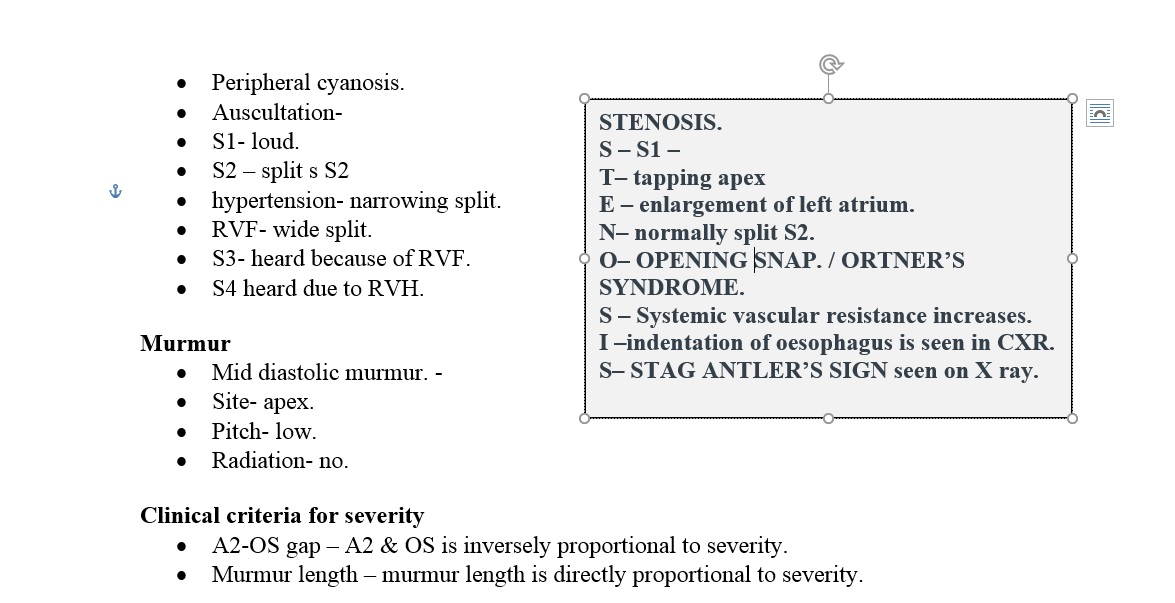
Clinical criteria for severity
- A2-OS gap – A2 & OS is inversely proportional to severity.
- Murmur length – murmur length is directly proportional to severity.
CLASSIFICATION OF SEVERITY OF MITRAL VALVE STENOSIS
| Mild | Moderate | Severe | |
| Mean gradient (mmHg) | less than 5 | 5 to 10 | more than 10 |
| Pulmonary artery systolic pressure (mmHg) | less than 30 | 30 to 50 | greater than 50 |
| Valve area (cm2) | < 1.5 | 1.0 to 1.5 | less than 1.0 |
INVESTIGATIONS
- Chest x-ray- PA view.
- Carinal angle will become blind.
- Double atrial shadow.
- RV type of apex.
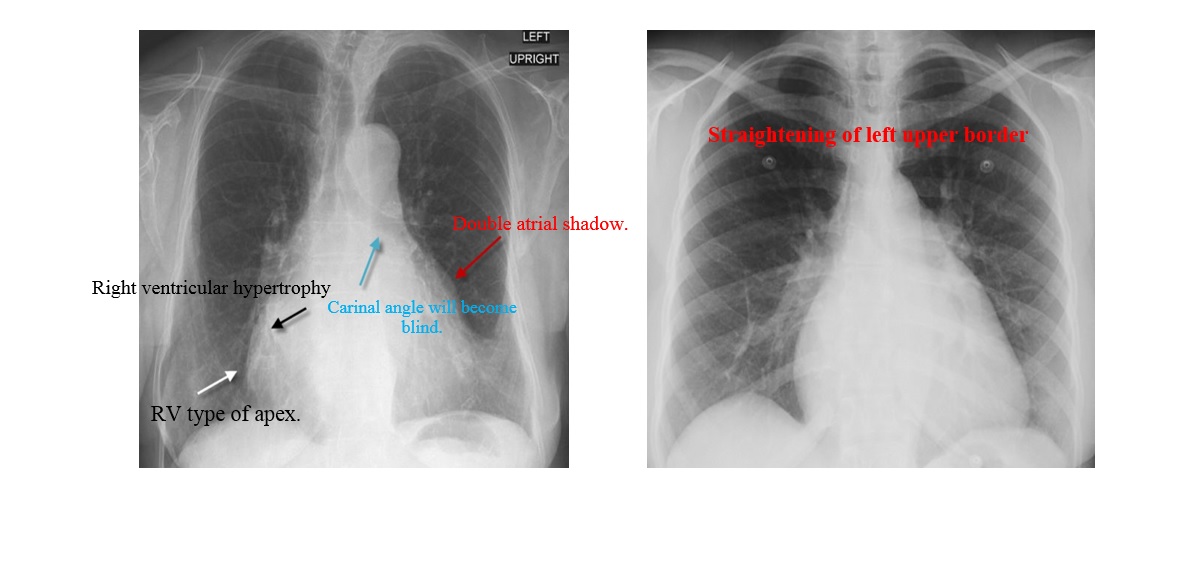
ECG-
- LA enlargement in lead II, P wave widening, .> 2.5mm- P MITRALE.
- RVH sign- right axis deviation, >+ 110.
- 2 D ECHO CARDIOGRAPHY.
- TRANS THORACIC ECHOCARDIOGRAPHY.
- CARDIAC CATHETERISATION.
DIFFERENTIAL DIAGNOSIS
- Left atrial myxoma
- Endocarditis
COMPLICATIONS
- Heart failure
- Stroke
- Failure to thrive
- Pulmonary hypertension
- Endocarditis
- Management of Mitral stenosis
- Medical management – treatment for AF, Pulm. Oedema , infective endocarditis.
- Surgical management– Balloon mitral valvotomy. Mitral valve replacement.
HOMOEOPATHIC MANAGEMENT OF MITRAL STENOSIS
NAJA TRIPUDIANS – chronic hypertrophy with valvular lesions .oppression in the chest with pulse irregular in force but regular in rhythm, threatened paralysis of heart.
CACTUS GRANDIFLORUS .- constriction as of an iron band with endocarditis, mitral insufficiency, cardiac incompetence, enlarged ventricles.
APIS MELLIFICA .- oedema, effusion, retention of water within the tissues, feels as if each breath will be the last. insufficiency of mitral valve.
KALMIA LATIFOLIA.- cardiac troubles developed from rheumatism. Sharp pain in the heart with extreme dyspnoea and anguish. Palpitation worst leaning forward.
ADONIS VERNALIS.- mitral and aortic regurgitation. palpitation, dypnoea ,cardiac asthma, pulse rapid, irregular, irregular cardiac action.
DIGITALIS —The least movement causes violent palpitation, and sensation as if it would cease. Irregular heart especially of mitral disease. Very slow pulse. Intermits; weak. Sudden sensation as if heart stood still. Pulse weak, and quickened by least movement.
STROPHANTHUS.-Pulse quickened. Heart’s action weak, rapid irregular, due to muscular debility; and insufficiency.
ARSENICUM IODATUM– Irregular pulse. pain either with or without valvular disease, esp. when accompanied with induration of lung tissue.
LITHIUM CARBONIUM-Pains in heart before menses, and associated with pains in bladder, and before urinating; better, after. Trembling and fluttering in heart, extending to back.
AUR. METALLICUM.- Sensation as if the heart stopped beating for two or three seconds, with sinking at the epigastrium.Valvular lesions of arterio-sclerotic nature .
CRATAEGUS OXYCANTHA- Cardiac dropsy with Extreme dyspnea on least exertion, without much increase of pulse. Heart dilated; first sound weak. Valvular murmurs, angina pectoris with blueness of fingers and toes & all aggravated by exertion or excitement.
RUBRICS RELATED TO MITRAL STENOSIS
MITRAL
STENOSIS
1-CLARKE REP
- Clinical; Heart; Murmurs of
- Clinical; Heart; Intermittent
- Clinical; Heart; Palpitation of
- Clinical; Heart; Slow
- Clinical; Heart; Valvular disease of
2-PHATAK REP
- PHATAK REPERTORY; HEART; narrow space, as if in
- PHATAK REPERTORY; HEART; palpitation; breathlessness,with.
- PHATAK REPERTORY; HEART; palpitation; dyspnoea,with
- PHATAK REPERTORY; HEART; palpitation; mental exertion agg
3-KENT REP
- Chest; CONSTRICTION; Heart; walk erect, inability to
- Chest; OPPRESSION; Heart; thinking of it agg.
- Chest; OPPRESSION; Heart; respiration, deep
- Chest; PAIN; General; Heart; ascending agg.
- Chest; PAIN; General; Heart; palpitation, during
4-COMPLETE REP
- heart & circulation; HEART region; valves, valvular complaints; mitral
- heart & circulation; DEPOSITS; valves
- heart & circulation; MURMURS; valves of heart; deposits, from fibrous
- heart & circulation; MURMURS; valves of aorta, stenosis
- heart & circulation; PULSE, heartbeat; intermittent; long interval, exciting fear of death.
- heart & circulation; WEAKNESS; aorta; valves
REFERENCES-
1-Munjal Y. API textbook of medicine. 9th ed. Mumbai: Association of Physicians of India; 2012.
2-Boericke William. Pocket Manual of Homoeopathic Materia & Repertory ,9 e, New Delhi, BJain Publishers,2012
3-Author: Claudia Dima, MD, FACC; Chief Editor: Terrence X O’Brien, MD, MS, FACC
Heartorg. Medscape
4-Clarke JH. The Prescriber. Available from: http://www.homeoint. org/books1/clarkeprescriber/n.htm
5-Schroyens F Synthesis(Repertorium Homoeopathicum Syntheticum) 9.1 ed. New Delhi. B Jain Publishers;2008
Author :- Dr. Niharika Jain ,MD(Scholar)
Department of Practice Of Medicine ,GHMC ,Bhopal , MP
Email: [email protected]
Co-Author :-
Dr. Neeta Jain, MD (Medicine)
Prabha Multispeciality Homoeopathic clinic, Indore, MP
Email: [email protected]


